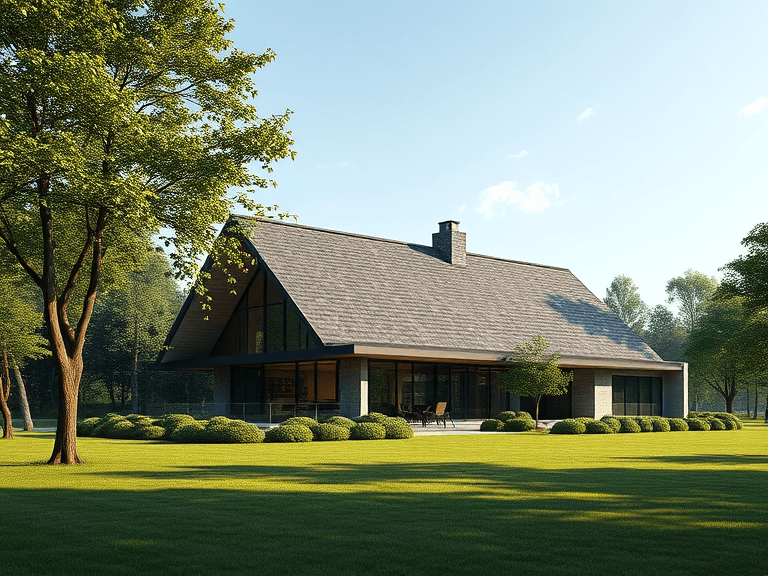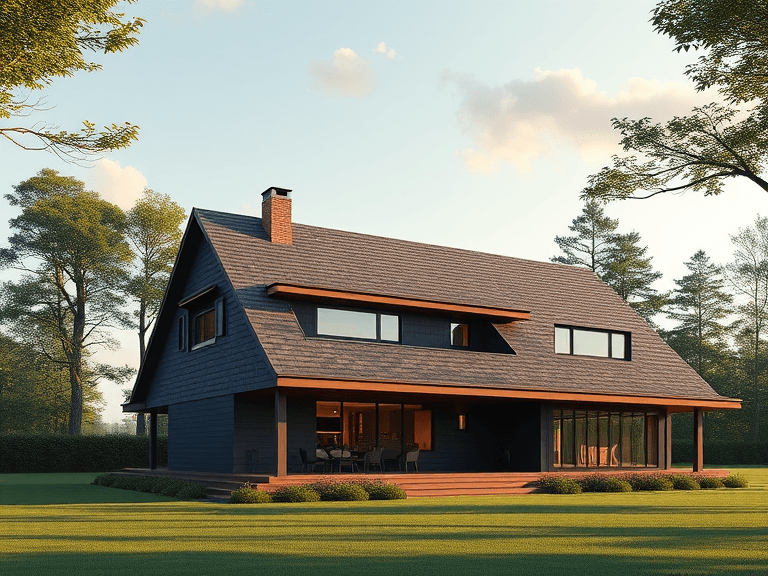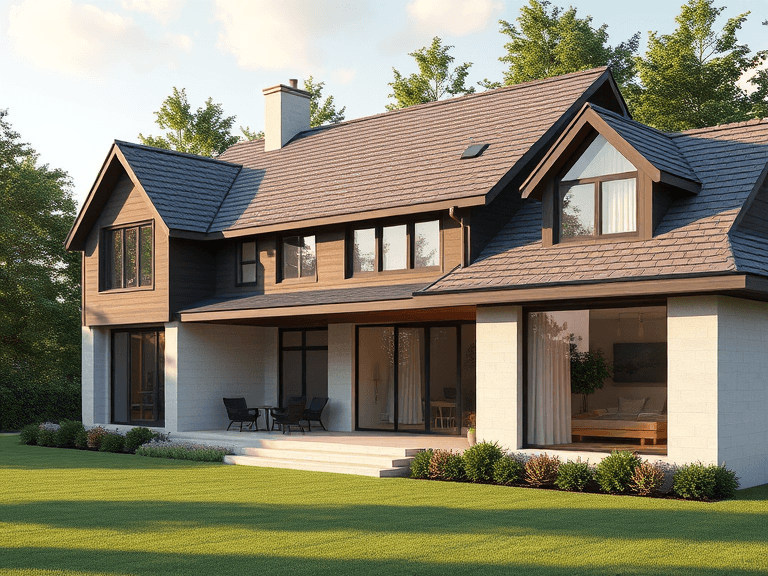
Flat roofs are architectural designs characterized by a horizontal or nearly level surface, as opposed to traditional sloped roofs. They are primarily composed of various materials such as asphalt, rubber, or foam, which are chosen for their ability to provide a waterproof barrier. Flat roofs are commonly employed in both residential and commercial buildings, serving a range of purposes from providing additional usable space to enhancing aesthetic appeal.
The evolution of flat roof design can be traced back to ancient civilizations, where they were utilized for practical purposes, such as providing outdoor living areas. Their popularity surged during the 20th century, particularly with the advent of modernist architecture, which emphasized minimalism and functionality. This architectural trend showcased the flat roof as an innovative solution that not only maximizes usable area but also aligns well with contemporary design principles. Today, flat roofs are often found in urban environments due to their efficient use of space and potential for rooftop gardens, terraces, or installations for solar panels.
In residential settings, homeowners may opt for flat roofs because they can facilitate easier access for maintenance and provide a stylish, modern look. On the commercial side, flat roofs allow for mechanical equipment installation without disrupting the overall architectural integrity of the building. This versatility makes flat roofs a popular choice across various industries. However, while the advantages of flat roofs are numerous, there are also potential drawbacks that warrant consideration. Understanding both the benefits and challenges of flat roof installation is essential for making informed decisions that align with building needs and environmental factors.
Advantages of Flat Roof Installation
Flat roofs have become increasingly popular in both residential and commercial construction due to their array of benefits. One of the primary advantages of flat roof installation is cost-effectiveness. The materials required for flat roofing systems are often less expensive than traditional pitched roofs, leading to lower overall project costs. Moreover, the installation process typically requires less labor and time, further reducing expenses. According to a study by the National Roofing Contractors Association, homeowners can save up to 30% on labor costs when opting for a flat roofing system.
Another key advantage is the ease of maintenance and accessibility. Flat roofs offer a convenient surface that makes routine inspections and repairs more manageable. Unlike steeply pitched roofs, homeowners and maintenance personnel can safely traverse flat surfaces to clean gutters or apply repairs. This accessibility reduces risks associated with maintenance activities and encourages timely attention to potential issues, thus prolonging the roof’s lifespan.
Additionally, flat roofs provide opportunities for additional outdoor living space, which is increasingly valued in urban settings where land is limited. Homeowners can transform flat rooftops into terraces, gardens, or recreational areas, effectively expanding their usable square footage without needing to invest in costly extensions. This versatility is particularly advantageous for enjoying outdoor activities without compromising ground-level space.
Energy efficiency is another benefit associated with flat roofs. Many modern flat roofing systems can be designed with energy-efficient materials and insulation options. Reflective roofing materials, for instance, can help reduce heat absorption, leading to lower cooling costs in warmer climates. Studies indicate that homes with energy-efficient flat roofs often achieve savings of 20-30% on their annual energy bills.
In summary, the numerous advantages of flat roof installations, including cost-effectiveness, maintenance ease, expanded living space, and energy efficiency, contribute to their increasing appeal for a variety of building types. Understanding these benefits can aid in making informed decisions when considering roofing options.
Drawbacks of Flat Roof Installation
While flat roofs offer various advantages, there are notable drawbacks associated with their installation that must be considered. A major concern is water drainage. Unlike pitched roofs, which utilize gravity to channel water off the sides, flat roofs can face significant issues related to effective drainage. Water can pool on the surface if proper sloping and drainage systems are not implemented, leading to an increased risk of leaks and structural damage over time.
Ponding water is particularly problematic for flat roof installation. This accumulation can deteriorate roofing materials and may result in a shorter lifespan compared to pitched roofs, which often are more resilient under wet weather conditions. Furthermore, regular maintenance is required to remove debris and ensure that drainage systems remain functioning properly, contributing to ongoing costs for the property owner.
Another potential drawback is the vulnerability to leaks. The flat design exposes these roofs to various weather elements, which can wear down seals and joints, ultimately leading to leaks. This necessitates frequent inspections and repairs, potentially increasing long-term expenditure. Furthermore, flat roofs may perform poorly in certain climates, especially those that experience heavy snowfall or ice. The weight of snow can strain the roof, resulting in structural integrity issues.
Additionally, flat roofs may provide limited insulation capabilities when compared to their pitched counterparts, which can increase energy costs for heating and cooling over time. In conclusion, while flat roofs can be advantageous in many respects, understanding the drawbacks—such as water drainage challenges, susceptibility to leaks, and limitations in climate performance—is crucial for making an informed decision about roofing options.
Cost Considerations for Flat Roofs
When evaluating the financial implications of flat roof installation, it is essential to consider multiple facets, including the initial installation costs, ongoing maintenance expenses, and potential long-term savings attributed to energy efficiency. Generally, the upfront costs associated with flat roofs can be lower than those for pitched roofs, primarily due to their simpler structure and the reduced amount of materials required. This fundamental difference in design translates into cost savings during the initial phase of construction.
Nevertheless, it is crucial to factor in long-term financial considerations. Flat roofs often demand higher maintenance costs compared to pitched roofs. The flat surface may lead to water pooling, which can cause leaks and necessitate repairs. Moreover, standing water may accelerate material degradation, leading to more frequent replacement or resurfacing needs. Therefore, while the initial investment may be more economical, ongoing maintenance can offset these savings over time.
Another financial aspect of flat roofs worth examining is their potential for enhanced energy efficiency. Flat roofs can be outfitted with energy-efficient materials or roofing systems, which can lead to reduced energy consumption. These advancements can translate into lower heating and cooling costs, providing homeowners with significant long-term financial relief. Additionally, flat roofs may allow for the installation of rooftop gardens or solar panels, further improving energy efficiency and creating potential revenue streams.
When comparing the overall costs of flat versus pitched roofs, flat roofs may emerge as the more economically viable option in specific contexts. While they may incur higher maintenance expenses over time and potential repair costs, the reduced initial investment and contributions to energy efficiency can yield financial benefits in the long run. A thorough examination of these financial aspects is vital for homeowners considering flat roof installation, as it highlights the complex interplay between initial costs and long-term economic implications.

Design and Architectural Flexibility
The installation of flat roofs offers significant design and architectural flexibility that caters to modern building requirements. One prominent advantage is the capacity to create a sleek, contemporary look that aligns with minimalist aesthetics. Flat roofs can contribute to a streamlined silhouette, allowing buildings to integrate seamlessly into urban landscapes, thereby enhancing the overall visual appeal of structures.
Moreover, flat roofs provide the unique opportunity to incorporate green roofs and rooftop gardens. These spaces not only enhance the ecological value of a property but also create areas for leisure and relaxation. Green roofs can assist in managing stormwater, improving air quality, and providing insulation, all while contributing to the reduction of the urban heat island effect. Rooftop gardens can serve multiple functions, from recreational spaces for occupants to leisure areas that improve the appeal of the structure to potential buyers or tenants.
In addition to aesthetic benefits, flat roofs can foster design flexibility in terms of layout and usage. Unlike pitched roofs, which may require specific structural considerations, flat roofs allow for the efficient use of space, maximizing the footprint of a building. This versatility accommodates various uses, such as additional living or working spaces, which can be particularly advantageous in densely populated areas where real estate is limited.
Numerous innovative flat roof designs can inspire architects and builders alike. For instance, a mixed-use development could feature a rooftop restaurant with panoramic views, while a residential property might showcase a generous terrace for outdoor entertaining. With the appropriate application of flat roofs, property owners can maximize their investment through striking designs that foster functionality and aesthetic appeal.
Climate Considerations for Flat Roofs
The performance and durability of flat roofs can be significantly influenced by climate conditions. Different geographical areas experience varying weather patterns that can impact the efficacy of flat roof installation. For instance, regions that encounter heavy rainfall or snowfall may face challenges in managing excessive water weight and runoff, which can lead to structural issues over time. In such climates, it is essential to consider the design and materials chosen for the flat roof to ensure longevity and resistance to weather-induced stress.
In areas with frequent rainfall, roofing materials that offer superior water resistance are vital. Modified bitumen and TPO (thermoplastic olefin) membranes are among the suitable options for flat roofs, as they provide excellent waterproofing capabilities. Additionally, the incorporation of proper drainage systems, such as scuppers and gutters, can help mitigate water accumulation and direct runoff effectively away from the roof surfaces. Proper installation techniques, including a slight slope towards drain points, also play a critical role in performance enhancement during wet weather.
On the other hand, flat roofs subjected to heavy snowfall require special consideration as well. Accumulation of snow can lead to considerable weight, which may compromise the structural integrity of the roof. To counter this, roofing materials should be durable and have the strength to support added weight, while also incorporating insulation to prevent ice dam formation. Furthermore, in regions experiencing extreme temperatures, it is advisable to select materials that can withstand thermal expansion and contraction, thereby preventing damage caused by temperature fluctuations.
In summary, climate considerations are paramount when installing flat roofs, and understanding the specific weather patterns of a region can guide the selection of appropriate materials and design approaches. By implementing tailored strategies to address climatic challenges, flat roofs can maintain their performance and durability over the years.
Maintenance and Longevity of Flat Roofs
Maintaining a flat roof is crucial for ensuring its longevity and overall performance. Unlike sloped roofs, which naturally shed water and debris, flat roofs require a more diligent maintenance routine to prevent water accumulation and related issues. Regular inspections should be conducted at least twice a year, as well as after adverse weather events, such as heavy storms or significant snowfall. During these inspections, homeowners should look for signs of damage, ponding water, cracked membranes, or visible debris that can impede drainage.
Common repair issues for flat roofs often arise from weathering, UV damage, or the breakdown of materials over time. Small cracks and blisters may appear, which can lead to leaks if not addressed promptly. Homeowners should be prepared to patch minor damage and replace any compromised sections of roofing material. It is advisable to consult professional roofing services for more extensive repairs, as incorrect handling can exacerbate existing issues.
Proactive measures play a vital role in extending the lifespan of flat roofs. Investing in high-quality materials at the time of installation can reduce future maintenance needs. Additionally, applying protective coatings can enhance resistance to UV rays and help maintain the integrity of the roof surface. Homeowners should also ensure that gutters and drainage systems are clear of debris to facilitate proper water flow.
In conclusion, the relationship between maintenance and the longevity of flat roofs cannot be overstated. Regular inspections, timely repairs, and proactive care all contribute significantly to the durability of these roofing systems. By being attentive to the specific needs of flat roofs, homeowners can enjoy a reliable and long-lasting roof over their heads.
Environmental Impact and Sustainability
The environmental impact of roofing systems is a crucial consideration in today’s building practices. Flat roofs, in particular, have garnered attention for their potential to enhance energy efficiency and promote sustainability. One significant advantage of flat roofs is their capacity for incorporating eco-friendly materials. Many manufacturers now offer sustainable roofing solutions, such as reflective membranes and materials sourced from recycled content, which can significantly reduce a building’s overall carbon footprint.
Moreover, flat roofs provide an ideal platform for the installation of green roofs. These systems not only support vegetation but also contribute to biodiversity in urban settings. Green roofs can help mitigate the urban heat island effect by absorbing sunlight and providing insulation, thus reducing the need for excessive air conditioning during warmer months. As a result, a flat roof with a green roofing system can facilitate significant energy savings while improving air quality in densely populated areas.
The contribution of flat roofs to urban sustainability initiatives cannot be overlooked. Local governments and environmental organizations increasingly recognize the importance of green infrastructure, which includes flat rooftops designed for stormwater management. These roofs can absorb and filter rainwater, reducing runoff and decreasing the risk of flooding in urban regions. Additionally, the increased vegetation on flat roofs may contribute to improved urban resilience against climate change by reducing temperature fluctuations and providing a habitat for wildlife.
Thus, when considering an examination of the benefits and drawbacks of flat roof installation, it is essential to recognize the environmental advantages they present. By opting for flat roofing solutions, property owners can participate actively in promoting sustainable building practices, ensuring that their roofing decisions align with broader environmental goals. These systems not only offer practical benefits but also play a vital role in fostering a greener, more sustainable urban landscape.
Conclusion: Is a Flat Roof Right for You?
In summary, the decision to install a flat roof requires a careful consideration of its numerous benefits and potential drawbacks. Throughout this examination of the benefits and drawbacks of flat roof installation, we explored various factors that come into play, including affordability, ease of maintenance, and aesthetic appeal.
Flat roofs present distinct advantages that can make them an appealing choice for homeowners and commercial property owners alike. Their lower construction costs, minimalist design, and the ability to utilize the roof space for patios or gardens surely enhance their attractiveness. Moreover, flat roofs can facilitate the installation of modern heating, cooling, and solar energy systems. However, it is crucial to also weigh the associated challenges, such as the potential for water pooling, increased vulnerability to weather extremes, and the necessity for more frequent maintenance. Understanding these aspects is essential for making an informed decision.
Ultimately, determining whether a flat roof is the right choice for your building involves assessing your specific needs, budget, and local climate conditions. By reflecting on the pros and cons highlighted in this post, you can arrive at a conclusion that aligns with your long-term goals. Additionally, we encourage readers to share their personal experiences and insights regarding flat roof installations. Engaging in this dialogue not only fosters a sense of community but also provides valuable perspectives that can help others in making their decisions.
Your feedback is essential, and we welcome your comments on this topic. Whether you have successfully installed a flat roof or encountered challenges along the way, your experiences undoubtedly contribute to the broader discussion. Should you choose this roofing option, being well-informed is the first step towards ensuring satisfaction with your investment.




